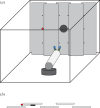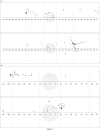Shrimps that pay attention: saccadic eye movements in stomatopod crustaceans
- PMID: 24395969
- PMCID: PMC3886330
- DOI: 10.1098/rstb.2013.0042
Shrimps that pay attention: saccadic eye movements in stomatopod crustaceans
Abstract
Discovering that a shrimp can flick its eyes over to a fish and follow up by tracking it or flicking back to observe something else implies a 'primate-like' awareness of the immediate environment that we do not normally associate with crustaceans. For several reasons, stomatopods (mantis shrimp) do not fit the general mould of their subphylum, and here we add saccadic, acquisitional eye movements to their repertoire of unusual visual capabilities. Optically, their apposition compound eyes contain an area of heightened acuity, in some ways similar to the fovea of vertebrate eyes. Using rapid eye movements of up to several hundred degrees per second, objects of interest are placed under the scrutiny of this area. While other arthropod species, including insects and spiders, are known to possess and use acute zones in similar saccadic gaze relocations, stomatopods are the only crustacean known with such abilities. Differences among species exist, generally reflecting both the eye size and lifestyle of the animal, with the larger-eyed more sedentary species producing slower saccades than the smaller-eyed, more active species. Possessing the ability to rapidly look at and assess objects is ecologically important for mantis shrimps, as their lifestyle is, by any standards, fast, furious and deadly.
Keywords: compound eye; eye movement; saccade; stomatopod; vision.
Figures




Similar articles
-
The independence of eye movements in a stomatopod crustacean is task dependent.J Exp Biol. 2017 Apr 1;220(Pt 7):1360-1368. doi: 10.1242/jeb.153692. J Exp Biol. 2017. PMID: 28356369 Free PMC article.
-
Stomatopod eye structure and function: a review.Arthropod Struct Dev. 2007 Dec;36(4):420-48. doi: 10.1016/j.asd.2007.01.006. Epub 2007 Mar 7. Arthropod Struct Dev. 2007. PMID: 18089120 Review.
-
Parallel processing and image analysis in the eyes of mantis shrimps.Biol Bull. 2001 Apr;200(2):177-83. doi: 10.2307/1543312. Biol Bull. 2001. PMID: 11341580 Review.
-
Filtering and polychromatic vision in mantis shrimps: themes in visible and ultraviolet vision.Philos Trans R Soc Lond B Biol Sci. 2014 Jan 6;369(1636):20130032. doi: 10.1098/rstb.2013.0032. Print 2014. Philos Trans R Soc Lond B Biol Sci. 2014. PMID: 24395960 Free PMC article. Review.
-
Combined eye-head gaze shifts in the primate. III. Contributions to the accuracy of gaze saccades.J Neurophysiol. 1990 Dec;64(6):1873-91. doi: 10.1152/jn.1990.64.6.1873. J Neurophysiol. 1990. PMID: 2074470
Cited by
-
Landmark navigation in a mantis shrimp.Proc Biol Sci. 2020 Oct 14;287(1936):20201898. doi: 10.1098/rspb.2020.1898. Epub 2020 Oct 7. Proc Biol Sci. 2020. PMID: 33023415 Free PMC article.
-
Object detection through search with a foveated visual system.PLoS Comput Biol. 2017 Oct 9;13(10):e1005743. doi: 10.1371/journal.pcbi.1005743. eCollection 2017 Oct. PLoS Comput Biol. 2017. PMID: 28991906 Free PMC article.
-
Polarization contrasts and their effect on the gaze stabilization of crustaceans.J Exp Biol. 2021 Apr 6;224(Pt 7):jeb229898. doi: 10.1242/jeb.229898. J Exp Biol. 2021. PMID: 33692078 Free PMC article.
-
Colour vision in stomatopod crustaceans.Philos Trans R Soc Lond B Biol Sci. 2022 Oct 24;377(1862):20210278. doi: 10.1098/rstb.2021.0278. Epub 2022 Sep 5. Philos Trans R Soc Lond B Biol Sci. 2022. PMID: 36058241 Free PMC article. Review.
-
The independence of eye movements in a stomatopod crustacean is task dependent.J Exp Biol. 2017 Apr 1;220(Pt 7):1360-1368. doi: 10.1242/jeb.153692. J Exp Biol. 2017. PMID: 28356369 Free PMC article.
References
-
- Ahyong ST, Harling C. 2000. The phylogeny of the stomatopod Crustacea. Aust. J. Zool. 48, 607–642. (10.1071/ZO00042) - DOI
-
- Cronin TW, Marshall NJ. 1989. Multiple spectral classes of photoreceptors in the retinas of gonodactyloid stomatopod crustaceans. J. Comp. Physiol. A 166, 261–275. (10.1007/BF00193471) - DOI
MeSH terms
LinkOut - more resources
Full Text Sources
Other Literature Sources
Medical

